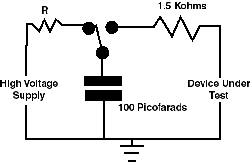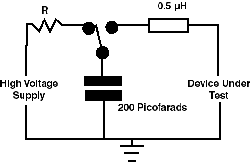<< Previous page INDEX Next page >>
5. Device Sensitivity and Testing
In Part Two, we indicated that one of the key elements in a successful static control program was the identification of those items (components, assemblies, and finished products) that are sensitive to ESD and the level of their sensitivity. Damage to an ESDS device by the ESD event is determined by the device's ability to dissipate the energy of the discharge or withstand the current levels involved. This is known as device "ESD sensitivity" or "ESD susceptibility".
Some devices may be more readily damaged by discharges occurring within automated equipment, while others may be more prone to damage from handling by personnel. In this article we will cover the models and test procedures used to characterize, determine, and classify the sensitivity of components to ESD. These test procedures are based on the three primary models of ESD events: Human Body Model (HBM), Machine Model (MM), and Charged Device Model (CDM). The models used to perform component testing cannot replicate the full spectrum of all possible ESD events. Nevertheless, these models have been proven to be successful in reproducing over 95% of all ESD field failure signatures. With the use of standardized test procedures, the industry can
- Develop and measure suitable on-chip protection.
- Enable comparisons to be made between devices.
- Provide a system of ESD sensitivity classification to assist in the ESD design and monitoring requirements of the manufacturing and assembly environments.
- Have documented test procedures to ensure reliable and repeatable results.
Human Body Model
One of the most common causes of electrostatic damage is the direct transfer of electrostatic charge through a significant series resistor from the human body or from a charged material to the electrostatic discharge sensitive (ESDS) device. When one walks across a floor, an electrostatic charge accumulates on the body. Simple contact of a finger to the leads of an ESDS device or assembly allows the body to discharge, possibly causing device damage. The model used to simulate this event is the Human Body Model (HBM).The Human Body Model is the oldest and most commonly used model for classifying device sensitivity to ESD. The HBM testing model represents the discharge from the fingertip of a standing individual delivered to the device. It is modeled by a 100 pF capacitor discharged through a switching component and a 1.5kW series resistor into the component. This model, which dates from the nineteenth century, was developed for investigating explosive gas mixtures in mines. It was adopted by the military in MIL-STD-883 Method 3015, and is also used in ESD Association standard ESD STM5.1-1998 Revised: Electrostatic Discharge Sensitivity Testing -- Human Body Model. The Human Body Model circuit is presented in Figure 1.
Figure 1: Typical Human Body Model CircuitTesting for HBM sensitivity is typically performed using automated test systems. The device is placed in the test system and contacted through a relay matrix. ESD zaps are applied and the post stress I-V current traces are reviewed to see if the devices fail. The ESD Association HBM test standard was recently revised to include several technical changes. First, the number of zaps per stress level and polarity has been reduced from 3 to 1. Also, the minimum time interval between zaps has been reduced from 1 second to 300 milliseconds. The changes reduce the HBM qualification test time.
The second technical change is a revision in the HBM tester specifications. The maximum rise time for an HBM wave form measured through a 500 ohm load was increased from 20 to 25 nanoseconds. This will allow HBM test equipment manufacturers to build high pin count testers that typically have a higher parasitic test board capacitance that slows down the 500 ohm wave form.
Machine Model
A discharge similar to the HBM event also can occur from a charged conductive object, such as a metallic tool or fixture. Originating in Japan as the result of trying to create a worst-case HBM event, the model is known as the Machine Model. This ESD model consists of a 200 pF capacitor discharged directly into a component with no series resistor.As a worst-case human body model, the Machine Model may be over severe. However, there are real-world situations that this model represents, for example the rapid discharge from a charged board assembly or from the charged cables of an automatic tester.
Testing of devices for MM sensitivity using ESD Association standard ESD STM5.2-1999 (Revised): Electrostatic Discharge Sensitivity Testing -- Machine Model is similar to HBM testing. The test equipment is the same, but the test head is slightly different. The MM version does not have a 1,500 ohm resistor, but otherwise the test board and the socket are the same as for HBM testing.
Figure 2: Typical Machine Model CircuitCharged Device Model Testing
The transfer of charge from an ESDS device is also an ESD event. A device may become charged, for example, from sliding down the feeder in an automated assembler. If it then contacts the insertion head or another conductive surface, a rapid discharge may occur from the device to the metal object. This event is known as the Charged Device Model (CDM) event, and can be more destructive than the HBM for some devices. Although the duration of the discharge is very short--often less than one nanosecond--the peak current can reach several tens of amperes.Several test methods have been explored to duplicate the real-world CDM event and provide a suitable test method that duplicates the types of failure that have been observed in CDM caused field failures. Current work in the area is concentrating on two separate CDM test methods. One is termed CDM and best replicates the real world charged device event. The other addresses devices that are inserted in a socket and then charged and discharged in the socket. It is termed the socketed discharge model (SDM).
A draft standard for CDM (ESD DS5.3.1-1996—Device Testing: Charged Device Model) was published in 1996. It is anticipated that the standard will be published as a full standard early in 2000. The test procedure involves placing the device on a field plate with its leads pointing up, then charging it and discharging the device. Figure 3 illustrates a typical CDM test circuit.
Figure 3: Typical Charged Device Model TestSDM testing is similar to testing for HBM and MM sensitivity. The device is placed in a socket, charged from a high-voltage source and then discharged. This procedure is still a work in process and still has a number of limitations including too great a dependency on the specific design of the SDM tester. A technical paper on SDM testing was presented by the ESD Association SDM Device Testing standards working group at the October 1998 EOS/ESD Symposium.
Device Sensitivity Classification
Each of the device testing methods includes a classification system for defining the component sensitivity to the specified model (See Tables 1, 2, and 3). These classification systems have a number of advantages. They allow easy grouping and comparing of components according to their ESD sensitivity and the classification gives you an indication of the level of ESD protection that is required for the component.Table 1
ESDS Component Sensitivity Classification - Human Body Model
(Per ESD STM5.1-1998)
Class
Voltage Range
Class 0
<250 volts
Class 1A
250 volts to <500 volts
Class 1B
500 volts to < 1,000 volts
Class 1C
1000 volts to < 2,000 volts
Class 2
2000 volts to < 4,000 volts
Class 3A
4000 volts to < 8000 volts
Class 3B
>= 8000 volts
Table 2
ESDS Component Sensitivity Classification - Machine Model
(Per ANSI/ESD-S5.2-1999)
Class
Voltage Range
Class M1
<100 volts
Class M2
100 volts to <200 volts
Class M3
200 volts to <400 volts
Class M4
> or = 400 volts
Table 3
ESDS Component Sensitivity Classification - Charged Device Model
(Per EOS/ESD-DS5.3-1996)
Class
Voltage Range
Class C1
<125 volts
Class C2
125 volts to <250 volts
Class C3
250 volts to <500 volts
Class C4
500 volts to <1,000 volts
Class C5
1,000 volts to <1,500 volts
Class C6
1,500 volts to <2,000 volts
Class C7
=>2,000 volts
A fully characterized component should be classified using all three models: Human Body Model, Machine Model, and Charged Device Model. For example, a fully characterized component may have the following: Class 1B (500 volts to <1000 volts HBM), Class M1 (<100 volts MM), and Class C3 (500 volts to <1000 volts CDM). This would alert a potential user of the component to the need for a controlled environment, whether assembly and manufacturing operations are performed by human beings or machines.
A word of caution, however. These classification systems and component sensitivity test results function as guides, not necessarily as absolutes. The events defined by the test data produce narrowly restrictive data that must be carefully considered and judiciously used. The three ESD models represent discrete points used in an attempt to characterize ESD vulnerability. The data points are informative and useful, but to arbitrarily extrapolate the data into a real world scenario can be misleading. The true utility of the data is in comparing one device with another and to provide a starting point for developing your ESD control programs.
Summary
Device failure models and device test methods define the sensitivity of the electronic devices and assemblies to be protected from the effects of ESD. With this key information, you can design more effective ESD control programs.For Further Reference
- Avery, L.R., "Beyond MIL HBM Testing - How to Evaluate the Real Capability of Protection Structures, EOS/ESD Symposium Proceedings, 1991, ESD Association, Rome, NY.
- Avery, L.R., "Charged Device Model Testing: Trying to Duplicate Reality," EOS/ESD Symposium Proceedings, 1987, ESD Association, Rome, NY.
- Chaine, M., Verhaege, K., Avery, L., Kelly, M., Gieser, H., Bock, K., Henry, L.G., Meuse, T., Brodbeck, T., Barth, J., "Investigation into Socketed CEM (SDM) Tester Parasitics," EOS/ESD Symposium Proceedings, 1998, ESD Association, Rome, NY.
- EOS/ESD DS5.3-1996: Electrostatic Discharge Sensitivity Testing - Charged Device Model. ESD Association, Rome, NY.
- ESD STM5.2-1999 (Revised): Electrostatic Discharge Sensitivity Testing -- Machine Model. ESD Association, Rome, NY.
- ESD STM5.1-1998 Revised: Electrostatic Discharge Sensitivity Testing -- Human Body Model. ESD Association, Rome, NY.
- Geiser, H., and Haunschild, M., "Very Fast Transmission Line Pulsing of Integrated Structures and the Charged Device Model," EOS/ESD Symposium Proceedings, 1996, ESD Association, Rome, NY.
- Hyatt, Hugh, Calvin, Hugh, and Mellberg, Hans, "A Closer Look at the Human ESD Event," EOS/ESD Symposium Proceedings, 1981, ESD Association, Rome, NY.
- Kelly, M., et al, "A Comparison of Electrostatic Discharge Models and Failure Signatures for CMOS Integrated Circuit Devices," EOS/ESD Symposium Proceedings, 1995, ESD Association, Rome, NY.
- Pierce, Donald C., "Critical Issues Regarding ESD Sensitivity Classification Testing," EOS/ESD Symposium Proceedings, 1987, ESD Association, Rome, NY.
- Renninger, Robert G., "Mechanisms of Charged-Device Electrostatic Discharges," EOS/ESD Symposium Proceedings, 1991. ESD Association, Rome, NY.
- Russ, Christian., et al, "A Compact Model for the Grounded-Gate nMOS Behavior Under CDM ESD Stress," EOS/ESD Symposium Proceedings, 1996, ESD Association, Rome, NY.
- Verhaege, Koen, "Component Level ESD Testing," Review Paper, Microelectronics Reliability Journal, 1998.
- Verhaege, Koen., et al " Analysis of HBM ESD Testers and Specifications Using a 4th Order Lumped Element Model," EOS/ESD Symposium Proceedings, 1993, ESD Association, Rome, NY.
- Verhaege, Koen., et al, "Recommendations to Further Improvements of HBM ESD Component Level Test Specifications," EOS/ESD Symposium Proceedings, 1996, ESD Association, Rome, NY.
- Wada, Tetsuaki. "Study of ESD Evaluation Methods for Charged Device Model," EOS/ESD Symposium Proceedings, 1995, ESD Association, Rome, NY.


